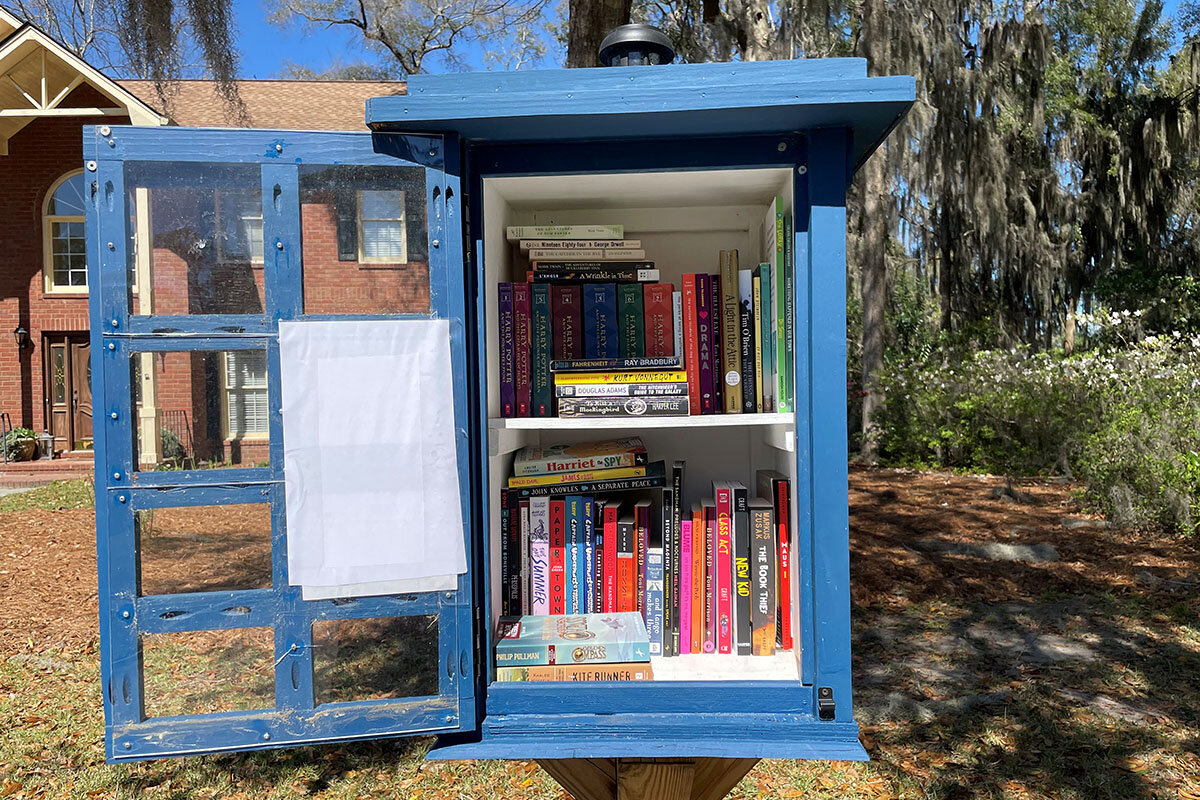From lawsuits to giveaway drives, a push against book bans
Loading...
| St. Louis
As daylight turns to dusk and a closed sign dangles from the outside of EyeSeeMe, a St. Louis children’s bookstore, a glance through a side window reveals an after-hours banned books operation. Paper strips litter the floor. Books pass from hand to hand as eight volunteers package 600 copies of “The Bluest Eye” by Toni Morrison to ship to kids and parents across the nation.
The bookstore is working in partnership with In Purpose Educational Services on the Banned Book Program, a donor-funded campaign that will send a free banned book each month to those who request one, as funding allows. Started just days after a school district in a suburb near St. Louis voted in January to remove copies of “The Bluest Eye” from its libraries, the program has already received over $30,000 from people around the nation. But Missouri residents aren’t the only ones taking action.
As school boards across the United States increasingly vote to remove books from library shelves and classroom curricula, community members are countering by amplifying awareness of those very books. These grassroots efforts – from free book drives to book clubs to lawsuits – differ in method but share a common mission to keep the world of books open for exploration.
Why We Wrote This
Banning books can have unintended consequences. In the United States, one result has been a redoubled effort to ensure those books – and the ideas they express – are freely available.
“If the school doesn’t want to do it [provide challenged books], still push them to do it, but don’t wait for them to do it,” says Jeffrey Blair, co-owner with his wife Pamela Blair, of EyeSeeMe, the bookstore supplying banned books for free each month. “Let’s empower ourselves.”
The Banned Book Program and similar initiatives across the country show “not only how important people think books are, but what people are willing to do ... to highlight that book, to protect that book, to get more people to read that book,” says Kathy M. Newman, an associate professor of English at Carnegie Mellon University in Pennsylvania.
A First Amendment challenge
Written by Nobel- and Pulitzer Prize-winning author Toni Morrison and published in 1970, “The Bluest Eye” tells the story of a young African American girl growing up in Lorain, Ohio, who longs for blue eyes. It addresses a range of themes, including racism, beauty standards, and the girl’s abusive home life.
After a community member in the Wentzville School District challenged the book, objecting to it on the grounds that it includes pedophilia, incest, and rape, the district’s school board voted on Jan. 20 to remove the book from district libraries. Less than a month later, two Wentzville students, represented by the American Civil Liberties Union of Missouri, filed a lawsuit saying the district’s removal of eight books, including “The Bluest Eye,” from school libraries violates their First Amendment rights.
Six of the other seven books the plaintiffs named have themes related to race or LGBTQ identity and were written by authors of color or LGBTQ authors. Their titles are “Fun Home: A Family Tragicomic,” by Alison Bechdel; “All Boys Aren’t Blue,” by George M. Johnson; “Heavy: An American Memoir,” by Kiese Laymon; “Lawn Boy,” by Jonathan Evison; “Gabi, A Girl in Pieces,” by Isabel Quintero; and “Modern Romance,” by Aziz Ansari and Eric Klinenberg. The seventh is “Invisible Girl” by Lisa Jewell, which explores a string of sexual assaults in a town and a teenage girl’s disappearance.
Brynne Cramer, chief communications officer for the Wentzville School District, confirmed via email that “The Bluest Eye,” “Gabi, A Girl in Pieces,” “Modern Romance,” and “Invisible Girl” have been returned to district libraries – the first two by school board votes in February and the second two because the challenges were dropped. The four other books named in the lawsuit have been removed from library shelves while they undergo review by a committee, said Ms. Cramer. The Wentzville School District declined to comment further.
Tony Rothert, director for integrated advocacy at the ACLU of Missouri and an attorney for the two Wentzville students, says the lawsuit is the first of its kind to emerge out of the recent wave of book challenges in the United States.
Despite the district’s partial reversal, the lawsuit is still ongoing.
“We’re hoping to have a change in the [Wentzville School District’s] policy such that it’s more protective of students’ First Amendment rights, that places some limits on how or why books can be challenged,” says Mr. Rothert.
T.K., a parent of one the plaintiffs who is using only initials in the lawsuit and interviews to protect the family’s anonymity, told the Monitor that books written by Black, brown, or LGBTQ authors can make students with similar backgrounds feel included. And banning them has the reverse effect. “If we’re not allowing kids to hear from people [through books] that may reflect or mimic some of the things that they’ve experienced, then we’re also telling them that you have to remain silent about things that you’ve experienced.”
Meanwhile, the Banned Book Program is working to ensure students retain access to books that highlight diverse experiences. The three books offered this month feature characters and/or authors of color.
“Literature should be a window and a mirror,” says Heather Fleming, founder and director of In Purpose Educational Services. “I’m tired of my experiences or my daughter’s experiences always being window experiences and not mirror experiences.”
“It seems a lot of African American books end up falling in that category of being banned,” adds Mr. Blair of the EyeSeeMe bookstore. “So, I think it’s important for us to be a part of this.”
Crossing state lines
Despite the increasing wave of book banning currently sweeping the United States, challenges and subsequent removals are nothing new. “Most of us don’t realize how often books are challenged,” says Dr. Newman, who started teaching a course on banned books over two decades ago.
But in the current period, book challenges are getting a brighter spotlight through social media. Consequently, interest is spreading across town and even state lines.
When Steve Ryan, an assistant professor of instruction at Temple University in Pennsylvania, heard that the McMinn County School Board in Tennessee removed “Maus” from its eighth-grade curriculum, he wanted to do something to push back.
Professor Ryan started a GoFundMe page to raise money for what he’s calling The Banned Wagon Project so that he can gift each graduating senior he teaches a banned book of their choice from a list of commonly banned or challenged books that he’ll compile.
He knows his actions won’t change policy in Tennessee, but “this is something that I can try to do ... to try to affect my little corner of the world,” he says. “And if one person takes away from it, you know, the inspiration to either stand up for people who are losing their voice, so to speak, or to take a stand against overreach ... then I call that a win. Even if somebody just carries that book around and remembers that words and ideas are important and they bring that forward into everything they do. That’s a win.”
Front-yard library
Around the same time, 700 miles away, at Savannah Arts Academy in Georgia, English teacher Rich Clifton engaged his students in a mock banned books debate. The next day, residents raised complaints at the district’s school board meeting about 10 books in school libraries containing content they viewed as inappropriate. Although the district confirmed on March 14 that no official book challenge has followed, Mr. Clifton, a teacher for 28 years, isn’t waiting to take action.
As a kid, Mr. Clifton spent hours in the public library, perusing the shelves and opening the cover of any book that caught his eye. Now, he’s replacing all the books in the little free library he built in his front yard with challenged books as a way of making sure they’re available. So far, former students, colleagues, and friends have contributed $1,400 to help purchase books for his library.
“It’s not so much [about] putting the books in the hands of students or children or anything like that,” he says.
“It’s making sure people don’t take it away.”
Editor’s note: All teachers and professors quoted in this article emphasized to the Monitor that they are speaking in their personal capacity and not on behalf of their school districts or universities.








